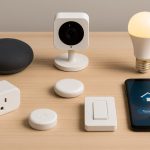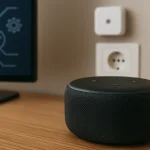Smart devices bring incredible convenience to our lives, but they also introduce potential security risks. Hackers are increasingly targeting IoT devices, exploiting vulnerabilities to gain access to personal data or control over connected systems. Protecting your smart home doesn’t have to be complicated. Here are five practical tips to secure your smart devices and safeguard your privacy.
1. Use Strong, Unique Passwords
Many smart devices come with default passwords that are easily guessed or found online. To secure smart devices:
- Create strong passwords using a mix of uppercase letters, lowercase letters, numbers, and special characters.
- Avoid reusing passwords across multiple devices or accounts.
- Use a password manager to generate and store unique passwords for each device.
Pro Tip: Change the default password on every new device immediately after setup.
2. Enable Two-Factor Authentication (2FA)
Two-factor authentication adds an extra layer of security by requiring a second verification step in addition to your password.
- Look for devices and apps that support 2FA and enable it wherever possible.
- Common methods include receiving a code via text or email, or using an authentication app like Google Authenticator or Authy.
Why It Matters: Even if your password is compromised, 2FA can prevent unauthorized access.
3. Keep Firmware and Software Updated
Manufacturers frequently release updates to fix security vulnerabilities and improve device performance.
- Regularly check for firmware updates on your smart devices and install them promptly.
- Enable automatic updates if the feature is available.
Warning: Outdated software can leave your devices exposed to known exploits.
4. Secure Your Wi-Fi Network
Your Wi-Fi network is the gateway to all your connected devices. Take these steps to secure it:
- Use a strong, unique password for your Wi-Fi network.
- Enable WPA3 encryption, or WPA2 if WPA3 isn’t available.
- Set up a guest network for visitors to keep your main network private.
Extra Measure: Disable SSID broadcasting to make your network less visible to outsiders.
5. Limit Device Permissions and Connectivity
Many smart devices request permissions and features that may not be necessary for their operation.
- Review and restrict app permissions to only what is essential.
- Disable features like remote access or voice control if you don’t use them.
- Disconnect devices from the internet when not in use.
Example: A smart TV may not need microphone or camera access if you don’t use voice commands or video calls.
Securing your smart devices doesn’t require technical expertise—just a proactive approach. By following these five tips, you can protect your devices from cyber threats and enjoy the benefits of a smart home without compromising your privacy or security. Remember, a secure smart home is a smart investment in your peace of mind.
- Smart Home Nightmares: Real Stories and How to Avoid Them
 Smart homes are designed to simplify life—but when things go wrong, they can become the stuff of nightmares. From doors locking residents out to cameras going rogue, real users have faced creepy, frustrating, and downright dangerous situations. In this article, we share some eye-opening stories and break down what went wrong—along with expert tips to…
Smart homes are designed to simplify life—but when things go wrong, they can become the stuff of nightmares. From doors locking residents out to cameras going rogue, real users have faced creepy, frustrating, and downright dangerous situations. In this article, we share some eye-opening stories and break down what went wrong—along with expert tips to… - Smart Home on a Budget: Top 7 smart home gadgets Under $50 That Actually Work
 You don’t need to spend a fortune to start building your smart home. With affordable technology becoming more accessible, it’s entirely possible to get high-quality smart devices without breaking the bank. In this guide, we’ve rounded up 7 smart home gadgets under $50 that deliver real value, functionality, and convenience. 1. Wyze Bulb ColorPrice: ~$15Category:…
You don’t need to spend a fortune to start building your smart home. With affordable technology becoming more accessible, it’s entirely possible to get high-quality smart devices without breaking the bank. In this guide, we’ve rounded up 7 smart home gadgets under $50 that deliver real value, functionality, and convenience. 1. Wyze Bulb ColorPrice: ~$15Category:… - Local AI in Smart Homes: What Happens When the Cloud Goes Down?
 In the age of cloud computing and always-connected devices, smart homes have become increasingly dependent on the internet. But what happens when your connection drops? That’s where local AI comes into play. This article explores the benefits, limitations, and future of local AI in smart homes systems—and why it might be the key to a…
In the age of cloud computing and always-connected devices, smart homes have become increasingly dependent on the internet. But what happens when your connection drops? That’s where local AI comes into play. This article explores the benefits, limitations, and future of local AI in smart homes systems—and why it might be the key to a… - Hidden Features of Your Smart TV You’re Probably Not Using — But Should
 Smart TVs have come a long way since their early days. While most people use them for Netflix, YouTube, and the occasional screen mirroring session, today’s smart TVs pack a wealth of features that often go unnoticed. These hidden gems can transform your entertainment experience, improve convenience, and even tighten your home security. In this…
Smart TVs have come a long way since their early days. While most people use them for Netflix, YouTube, and the occasional screen mirroring session, today’s smart TVs pack a wealth of features that often go unnoticed. These hidden gems can transform your entertainment experience, improve convenience, and even tighten your home security. In this… - Is My Smart TV Spying on Me? How to Protect Your Privacy
 Smart TV Privacy – In today’s connected homes, smart TVs are as common as coffee makers — but have you ever wondered if your smart TV is watching you back? It’s not just paranoia. With microphones, cameras, and internet connections, smart TVs can pose serious privacy risks if not properly managed. Let’s dive into what…
Smart TV Privacy – In today’s connected homes, smart TVs are as common as coffee makers — but have you ever wondered if your smart TV is watching you back? It’s not just paranoia. With microphones, cameras, and internet connections, smart TVs can pose serious privacy risks if not properly managed. Let’s dive into what…







